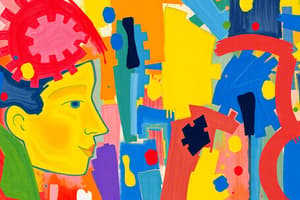Podcast
Questions and Answers
According to the diagnostic criteria in the DSM-5, which combination of factors is necessary for diagnosing Autism Spectrum Disorder?
According to the diagnostic criteria in the DSM-5, which combination of factors is necessary for diagnosing Autism Spectrum Disorder?
- Presence of unusual sensory preferences and advanced abilities in specific academic areas.
- Deficits in language development and difficulty with motor coordination.
- Persistent deficits in social communication and interaction, along with at least two types of restricted repetitive behaviors. (correct)
- Significant delays in cognitive abilities and lack of emotional expression.
What is a key reason why individuals with autism may find it challenging to succeed in traditional social environments?
What is a key reason why individuals with autism may find it challenging to succeed in traditional social environments?
- Communication deficits combined with difficulty in abstract thinking. (correct)
- Anxiety related to large groups due to sensory processing sensitivities.
- Superior intellectual abilities that make them bored in typical social interactions.
- A strong preference for physical activities and outdoor settings.
At what age is autism typically diagnosed?
At what age is autism typically diagnosed?
- At birth
- During adolescence
- Around the age of 10
- Around the age of 4 (correct)
An individual with autism is easily overwhelmed by bright lights and loud sounds. Which diagnostic criterion does this align with?
An individual with autism is easily overwhelmed by bright lights and loud sounds. Which diagnostic criterion does this align with?
How has the prevalence of autism been changing in recent years?
How has the prevalence of autism been changing in recent years?
Which of the following is an example of a 'stereotyped movement' as it relates to autism?
Which of the following is an example of a 'stereotyped movement' as it relates to autism?
Which statement best reflects the understanding of a 'cure' for autism?
Which statement best reflects the understanding of a 'cure' for autism?
Considering the historical classifications within the autism spectrum (prior to 2013), which of the following best describes Pervasive Developmental Disorder Not Otherwise Specified (PDD-NOS)?
Considering the historical classifications within the autism spectrum (prior to 2013), which of the following best describes Pervasive Developmental Disorder Not Otherwise Specified (PDD-NOS)?
If a child is diagnosed with autism and also presents symptoms of hyperactivity and impulsivity, which co-morbid disorder is most likely to be considered?
If a child is diagnosed with autism and also presents symptoms of hyperactivity and impulsivity, which co-morbid disorder is most likely to be considered?
Why is it important for interventions for autism to be individualized and evidence-based?
Why is it important for interventions for autism to be individualized and evidence-based?
A child with autism consistently wants to eat the same brand of pasta for every meal and becomes distressed if a different brand is offered. Which characteristic of autism does this behavior exemplify?
A child with autism consistently wants to eat the same brand of pasta for every meal and becomes distressed if a different brand is offered. Which characteristic of autism does this behavior exemplify?
Considering autism's impact on social interaction, which of the following would be most affected?
Considering autism's impact on social interaction, which of the following would be most affected?
Leo Kanner is noted for what contribution to the field of autism research?
Leo Kanner is noted for what contribution to the field of autism research?
What does it typically mean when a professional makes a 'differential diagnosis' regarding a patient with suspected autism?
What does it typically mean when a professional makes a 'differential diagnosis' regarding a patient with suspected autism?
A child with autism shows a great interest in collecting rocks and sorts them by color, size and shape, spending hours on this activity. According to the diagnostic criteria, this behavior aligns with:
A child with autism shows a great interest in collecting rocks and sorts them by color, size and shape, spending hours on this activity. According to the diagnostic criteria, this behavior aligns with:
Flashcards
What is Autism?
What is Autism?
A developmental disability affecting communication and social interaction, impacting educational performance.
Characteristics of Autism
Characteristics of Autism
Repetitive movements, resistance to change, unusual sensory responses, and a preference for routines.
Deficits in social communication
Deficits in social communication
Social Emotional Reciprocity, Nonverbal Communicative Behaviors, Maintaining Relationships
Restricted repetitive behaviors
Restricted repetitive behaviors
Signup and view all the flashcards
Communication Cues (Autism)
Communication Cues (Autism)
Signup and view all the flashcards
Behavioral Cues (Autism)
Behavioral Cues (Autism)
Signup and view all the flashcards
Social Cues (Autism)
Social Cues (Autism)
Signup and view all the flashcards
Challenges related to Autism.
Challenges related to Autism.
Signup and view all the flashcards
Comorbid Disorders with Autism
Comorbid Disorders with Autism
Signup and view all the flashcards
Study Notes
- Autism is a developmental disability affecting verbal/nonverbal communication and social interaction, therefore it affects educational performance
Other Characteristics
- Repetitive activities are a characteristic
- Stereotyped movements may occur
- Resistance to change may be present
- Unusual responses to sensory stimulus can be shown
- A routine oriented way of thinking is part of autism
- Lack of social awareness is a characteristic
Facts about Autism
- It was first discovered in 1943 by Leo Kanner
- It occurs in 1 in 36 children
- There has been a 317% increase since 2000
- 1 in 45 adults are affected by autism
- It is ~4 times more prevalent in boys than girls
- Symptoms are evident between ages 2-5
- There is no known cause of autism
- There is no current cure
- It occurs in all races, ethnicities, and social groups
The Autism Spectrum Until 2013
- Included Autistic Disorder (AD)
- Included Asperger's Disorder (AS)
- Included Pervasive Developmental Disorder, Not Otherwise Specified (PDD-NOS)
- Included Rett's Syndrome
- Included Childhood Disintegrative Disorder (CDD)
Diagnostic Criteria
- The DSM-5 notes a need for persistent deficits in each of the 3 areas of social communication and interaction
- There must be at least two of four types of restricted repetitive behaviors
Social communication and interaction
- Social Emotional Reciprocity is affected
- Nonverbal Communicative Behaviors are impacted
- Developing, Maintaining and Understanding Relationships are impacted
Repetitive Behaviors
- Stereotyped or repetitive motor movements can occur
- Insistence on sameness is part of the criteria
- Highly restricted, fixated interests can develop
- Hyper- or Hypo-reactivity to sensory input often presents
Diagnosis
- Children are usually diagnosed around the age of 4
- It is often diagnosed initially as a developmental delay
- Diagnoses are given by qualified professionals
- The professional will use a variety of information when diagnosing
- Differential diagnosis or co-morbidities are important factors for a professional to consider when diagnosing
Common Co-Morbid Disorders/Diagnoses
- ADHD
- Intellectual Disability (ID)
- Obsessive Compulsive Disorder (OCD)
- Learning Disability (LD)
- Anxiety
- Bipolar Disorder
- Sensory Integrations Disorder
- Medical Complications (e.g., seizures, etc.)
Recognizing Autism
- Communication Cues
- Behavioral Cues
- Social Cues
Challenges with Autism
- Communication deficits and intense preoccupations can lead to very challenging behaviors
- Limited, repetitive interest can make it difficult to engage an individual in a variety of conversational topics
- Limited interests and difficulty with abstract thinking can make it hard for individuals to be successful in traditional social environments
Treatment and Interventions
- Treatment helps to reduce symptoms that interfere with daily functioning and quality of life
- Can occur in any environment
- There are multiple types of treatment
Key points
- Autism is a complex and highly variable disorder
- There are core deficits in social communication and repetitive behavior
- There can be comorbid ID, Behavior, and/or psychiatric disorders present
- Evidence-based and individualized interventions are what is most successful
Studying That Suits You
Use AI to generate personalized quizzes and flashcards to suit your learning preferences.



